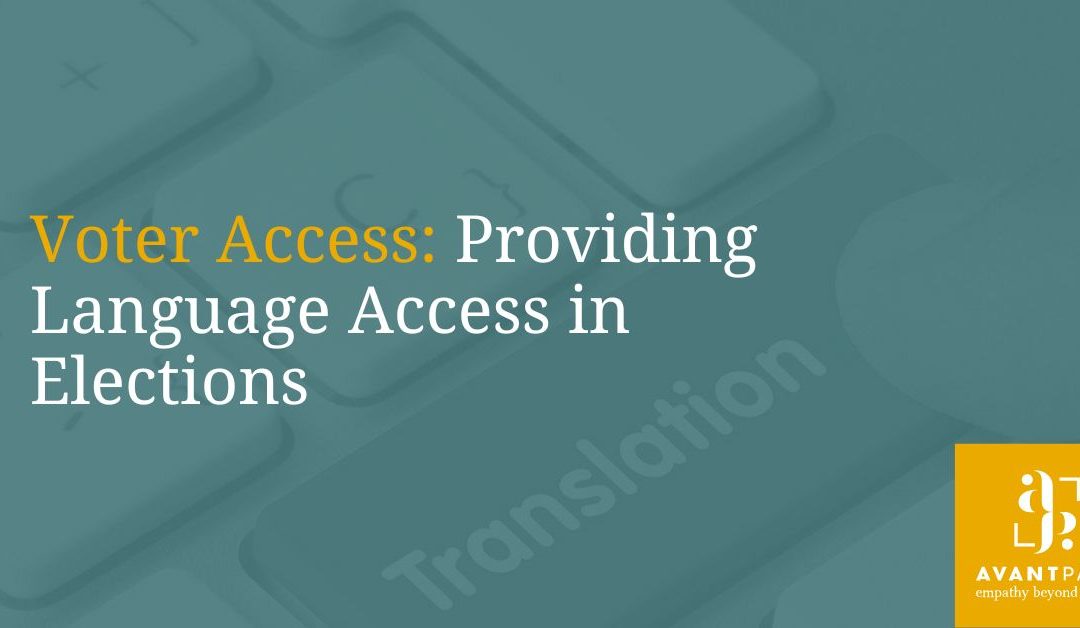Providing voting materials in non-English languages helps to encourage participation in the voting process and capture the voices of those in underrepresented and limited English proficient (LEP) communities. It also helps to sustain our society’s democratic process.
Providing language access for LEP individuals also supports government in other ways. We’ll share how and provide five ways to increase voter turnout for LEP communities.
Multilingual Materials Support Voter Access
Here are four ways multilingual materials support voter access.
#1 Voter Access Encourages Participation from Underrepresented Communities
When LEP individuals have voting materials in their native language, it encourages them to participate in the process. It makes the entire voting process much easier and more engaging. Voter access by means of providing language access “encourages members of historically underrepresented communities to participate in elections, and ensures that all individuals can vote comfortably and knowledgeably.”
#2 Voter Access Increases Voter Turnout
The Voting Rights Act has increased voter turnout over time:
- Thirty years after the Voting Rights Act was amended in 1975 to expand voter access, Hispanic voter registration has doubled.
- Voting by language minority groups has increased, especially for first-generation citizens, in counties that provide language assistance.
- Language assistance, including Spanish-language ballots, makes it easier for immigrants to vote, contributing to higher voter turnout.
In addition, language assistance is symbolic and helps to encourage participation in our democratic system for LEP individuals and English-speakers alike. There is a “sense that they feel more comfortable and welcomed in polling places in which there is increased descriptive presence from language-minority communities, and visible provision of multilingual services.”
#3 Voter Access Encourages a More Diverse Representation Among Elected Officials
Language access motivates language minorities to run for office in more significant numbers. Community leaders have “explicitly acknowledged that the changes that enforcement activity brought about in the conduct of their local elections encouraged them to run for office.” With more significant numbers comes an increase in representation.
#4 Voter Access Improves the General Public’s Faith and Trust in the Government
Reports have shown that language access to voting correlates to improvement in faith to the law. By “deepening relationships between public officials, the communities they represent, and the voters who elect them, effective language assistance efforts increase faith and trust in government.” More voters will help support our democracy and society.
Voter Access Resources: How to Increase Voter Turnout
Here are five ways to provide more language support to increase voter turnout.
#1 Get More Data About Your LEP Communities
The more you know about your LEP communities, the better you can serve them. Learn more about locating language information in different demographic areas. This guide provides instructions on how to locate demographic data using data.census.gov.
#2 Add Additional Language Support Beyond the Federal Requirements
In addition to the federal requirements under the Language Minority Provisions of the Voting Rights Act, government agencies can take the following actions to support voter access:
- Lower your threshold language percentage requirement
- Choose the threshold language percentage based on precinct instead of county, which is similar to what the California Voter Choice Act is about
- Translate beyond percentage-based thresholds by also including the top languages spoken by LEP voters and/or also including another tier for the top languages based on the non-English language spoken at home regardless of English-language capabilities
- Use the top languages spoken at the state level and add the top languages spoken at the county level
- Mix and match these to bridge outside of percentage requirements to better meet the needs of your voters
#3 Partner with Local Organizations
Look at local cultural organizations to find one you can partner with to get the word out about voting. Translate voting material communications, and share these with local organizations. Consider in-language pieces for local news, magazines or newsletters.
#4 Use Interagency Resources
Leverage interagency resources such as a Language Accessibility Advisory Committee (LAAC), Voting Accessibility Advisory Committee (VAAC) or other resources that cover languages. You can participate in these committees as they are open to the public, and they’re a good way to see what other officials are doing. For example, the California LAAC and the translation advisory council in Oregon have monthly webinars for any participants.
#5 Know Your Audience
Understand how your audience wants to be communicated with for different types of communication, such as print, digital or radio, as well as different platforms for diverse audiences. If you aren’t sure, look at your digital analytics or consult with local leaders to understand where these audiences go for information.
Conclusion
Democracy benefits by having active participation in the voting process. Providing language support can encourage underrepresented and LEP communities to vote. State, country or city government agencies can support their LEP communities in several ways through language access.
As a translation company supporting the language needs of immigrants and LEP communities, we’ve been translating election materials for over 25 years. We can provide you with language resources and experienced translators to translate the content. Contact us at [email protected] or (530) 750-2040 to learn more.
